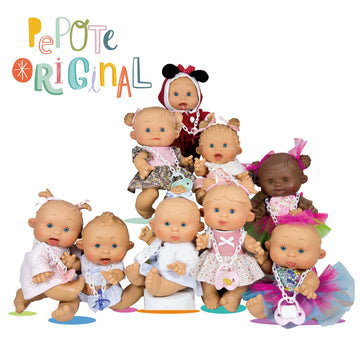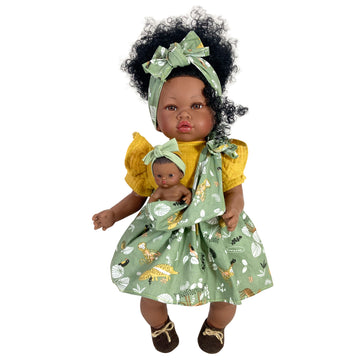Dolls And Accessories - Questions
Dolls And Accessories - Questions
Blog Article
What Does Dolls And Accessories Mean?
Table of ContentsThe 2-Minute Rule for Dolls And AccessoriesA Biased View of Dolls And AccessoriesFascination About Dolls And AccessoriesDolls And Accessories Things To Know Before You Get ThisThe Buzz on Dolls And AccessoriesThe smart Trick of Dolls And Accessories That Nobody is DiscussingThe 5-Second Trick For Dolls And Accessories
When dolls are consisted of in team play, kids exercise waiting, sharing, and paying attention to others' ideas. Whether they're making believe to be a moms and dad, brother or sister, or good friend, kids discover how relationships workhow to support others, fix differences, and take care of somebody else. These very early role-play experiences become the groundwork for healthy relationships and connections later in life.Repeating calming routines with a doll (feeding, rocking, closing) can help kids really feel tranquil and secure. These calming routines show them how to self-regulate. Taking treatment of a doll can make a child feel capable and confident - european dolls. It provides them a feeling of duty and control in a world that usually really feels uncertain.
The 8-Second Trick For Dolls And Accessories
When children see dolls that reflect their race, heritage, and culture, it enhances a favorable feeling of identity. It claims, "You belong. Your tale matters." Dolls also present children to cultures outside their own, developing respectful inquisitiveness and empathy for others. This is where comprehensive play can cause inclusive neighborhoods.
As Dr. Karyn Purvis, a leader in child development and trauma-informed care, when stated: This powerful quote highlights exactly how play isn't simply funit's exactly how children learn finest. The brain wires itself through repetition. When a kid is engaged, happy, and mentally connected to an activitylike doll playthe brain enhances those connections quicker and more meaningfully.
What Does Dolls And Accessories Mean?

Children need compassion, generosity, and imagination tooand doll play uses that. Dolls are commonly a child's first "friend," aiding them practice connections, construct interaction abilities, and feel comforted.
The Definitive Guide to Dolls And Accessories
Through dolls that matter. Samantha Ong Samantha Ong is the founder of Joeydolls, a Canadian-based toy brand name on a goal to commemorate Oriental societies through happy, comprehensive play. Inspired by her own experiences expanding up without social representation, Samantha designs dolls that aid youngsters feel pleased of who they are while triggering inquisitiveness and empathy in others.
Playing with dolls motivates kids to chat even more concerning others' thoughts and feelings, a research study has actually located. The research study suggests that playing imaginary video games with dolls might assist kids create social their explanation skills, concept of mind and compassion.
The 45-Second Trick For Dolls And Accessories
They were also most likely to deal with the dolls in the 2nd person, speaking to them directly, whereas the personalities on the computer display they tended to refer to in the 3rd individual. No distinction was observed between boys and ladies."Internal state language can suggest that a youngster is considering other individuals's ideas and emotions while playing with dolls," claimed Gerson.
Which they see language usage hereof is excellent confirmation of the hypothesis."Mardell added that the findings should use to any kind of type of role-play toy, as opposed to specifying to Barbies. "I would certainly take a more comprehensive view of what a doll is," he said." [Maybe] any type of object that the kid can spend a sense of various other right into a packed animal, an oven mitt that speaks to them, or perhaps an imaginary good friend."Kid generally begin to reveal indicators of interior state language around the age of 4.
The Facts About Dolls And Accessories Uncovered
"It ends up being vital for making and sustaining relationships, and how they pick up from their teachers, and parents."The research additionally found that the kids had increased mind task in the posterior superior temporal sulcus (pSTS) area when they talked as though their dolls had ideas and feelings. The pSTS region is thought to be associated with the growth of social and psychological processing skills.
Childhood is not a fixed life stage; certainly, the definition, meaning and understanding of childhood are all subject to adjustment. By the 19th century among the most extensive modifications was the value put on enabling youngsters to experience "the carefree happiness" of childhood years with play tasks. Play was now taken into consideration to be an essential component of an excellent youth.
In order to totally understand the meaning of play, one need to additionally recognize the value of the doll. Dolls are a lot even more than playthings created to captivate young ladies.
Not known Incorrect Statements About Dolls And Accessories

It is just through archaeological examinations that researchers can wish to discover and document the complete variety of play experiences. Chronicling these experiences, and specifically the duty of dolls, is important for presenting an extra complete photo of childhood during the 19th century. Alarcn, Sara E - doll accessories., "Child's Play: The Function of Dolls in 19th Century Childhood Years" (2007 )
Report this page